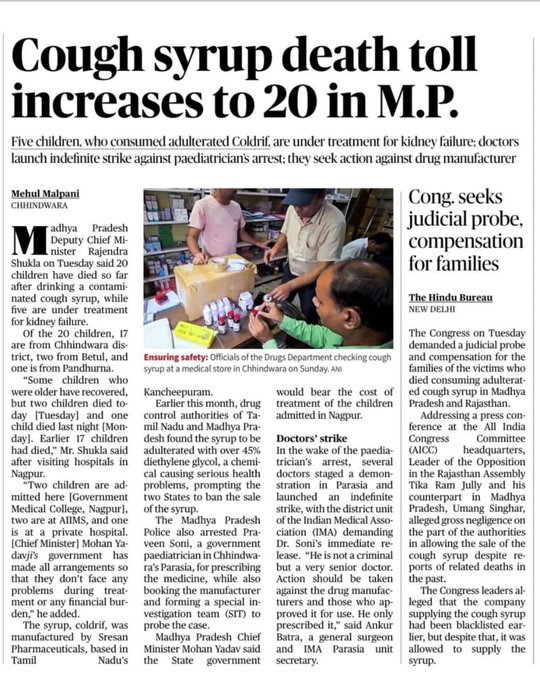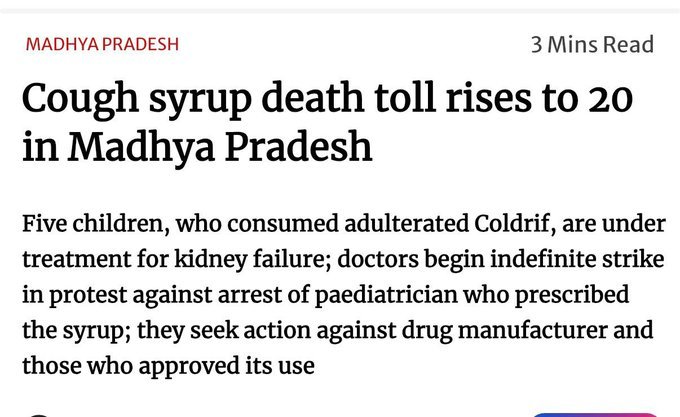In the quiet villages of Madhya Pradesh and Rajasthan, tragedy struck suddenly and brutally. A toxic cough syrup in India has claimed the lives of at least 20 children, igniting public outrage, grief, and urgent calls for accountability. Families are grief-stricken, and health authorities are scrambling to trace the origins of the contaminated medicine. What went so wrong, and how can India ensure this never happens again?
A Grim Discovery: How It All Unfolded
In late 2025, news filtered out from remote districts of Madhya Pradesh that several children had died after having been administered a locally procured cough syrup. Around the same time, reports emerged from border districts of Rajasthan with similar patterns children developing acute symptoms, and some succumbing within hours. Investigations revealed a disturbing commonality: the same brand or batch of toxic cough syrup in India.
According to local health officials, the symptoms included sudden vomiting, seizures, acute kidney failure, and metabolic disturbances. These catastrophic reactions set off alarm bells. The Food and Drugs Control Department (FDCD) teams were dispatched; police and forensic units joined in. The initial finding: the syrup contained a toxic chemical impurity possibly industrial solvent residues or adulterants unfit for human use.
The Human Toll and Public Outcry
These aren’t statistics. Each number represents a child lost a future stolen, a family left shattered. In a public meeting, mothers wept openly, demanding justice. State governments declared compensation for bereaved families and launched medical camps to screen other children who may have consumed the same batch of toxic cough syrup in India.
Civil society organizations and media have amplified demands for total transparency. Why was such a syrup permitted? Who approved its manufacture, distribution, and sale? And why were regulatory checks so lax that a poisonous batch could reach vulnerable rural communities?
Regulatory Gaps Exposed
This tragedy casts a stark spotlight on gaps in India’s pharmaceutical regulation, particularly in oversight of small-scale manufacturers and distribution in rural areas. Some major issues include:
- Weak quality control mechanisms: Local manufacturers often escape rigorous audits.
- Poor supply chain traceability: Distributors in rural belts sometimes bypass official channels.
- Corruption and collusion risks: In some cases, regulatory officials may be under-resourced or compromised.
- Slow reaction time: Even when problems are detected, recalls take days precious hours lost.
A key question remains: Who is culpable manufacturer, distributor, regulator, or all of them? The case of this toxic cough syrup in India must be a wake-up call for reform.

Why This Tragedy Matters for All of India
While this incident unfolded in Madhya Pradesh and Rajasthan, it should concern every Indian citizen. It is a harsh reminder that in the absence of robust safeguards, even essential medicines can become lethal.
Parents lose trust in health systems. Rural populations become vulnerable, believing that medicines might be more dangerous than the illness. Pharmaceutical exports and India’s reputation as “the pharmacy of the world” may suffer collateral damage. International partners will demand more assurances, strict audits, and transparent compliance systems. The story of this toxic cough syrup in India is not just about two states — it’s about the safety of every child in the nation.
Learning from Others: Strengthening Pharmaceutical Oversight
Countries that have successfully avoided such incidents follow several best practices:
- Mandatory batch-level serialization and tracking so any unit can be traced back to production.
- Third-party independent quality audits to reduce conflicts of interest.
- Harsh punishments and fast accountability when violations result in death or harm.
- Public transparency dashboards where consumers can check drug authenticity via QR codes.
India must raise its game. The tragic deaths caused by toxic cough syrup in India should serve as a turning point one that transforms the way the nation regulates its pharmaceutical supply chain.
Where Our Previous Work Connects
To understand how sweeping systemic reform is possible in India, look at our analysis on GST Reforms Big Relief to Middle Class 2025, where we explored how structural changes can transform public trust and governance.
You might also find relevance in Startups to Watch in the Indian Market, especially those focusing on health tech solutions for drug safety, traceability, and transparency innovations that could help prevent future tragedies like this toxic cough syrup in India crisis.
The Path Forward: What Must Be Done
- Immediate nationwide recall and chemical forensics to understand the precise toxin and how it entered.
- Arrest and prosecute all legally responsible parties manufacturers, importers, and regulators.
- Strengthen the Drugs and Cosmetics Act with clearer clauses on liability and consumer compensation.
- Fund rural health labs with modern testing equipment and trained staff at district level.
- Public awareness campaigns so that caregivers do not accept medicines without proper packaging and QR/verification codes.
Let the voices of the bereaved drive real reform. Let this tragedy not fade into statistics, but ignite a safer, more accountable India one where a toxic cough syrup in India can never again take the lives of innocent children.








